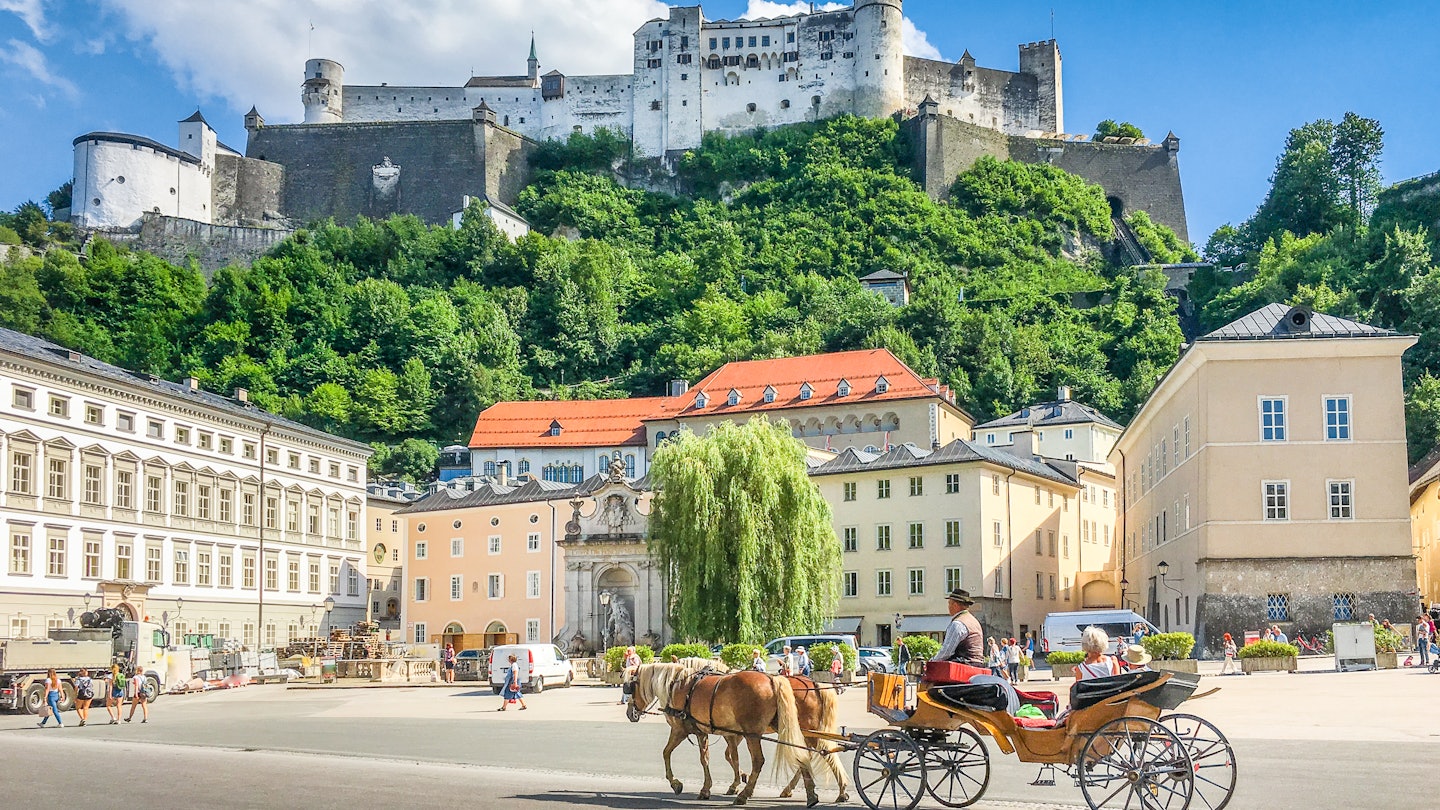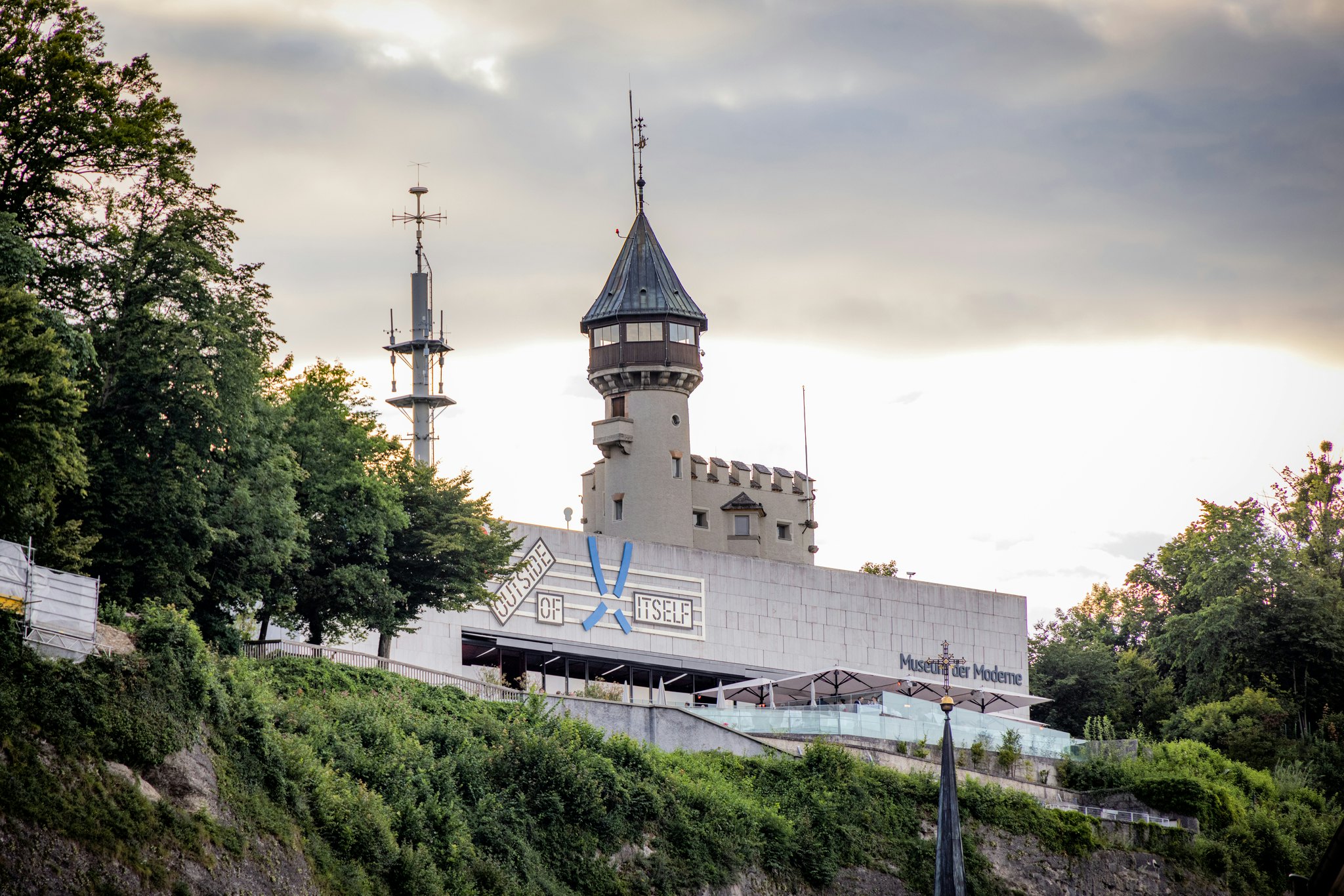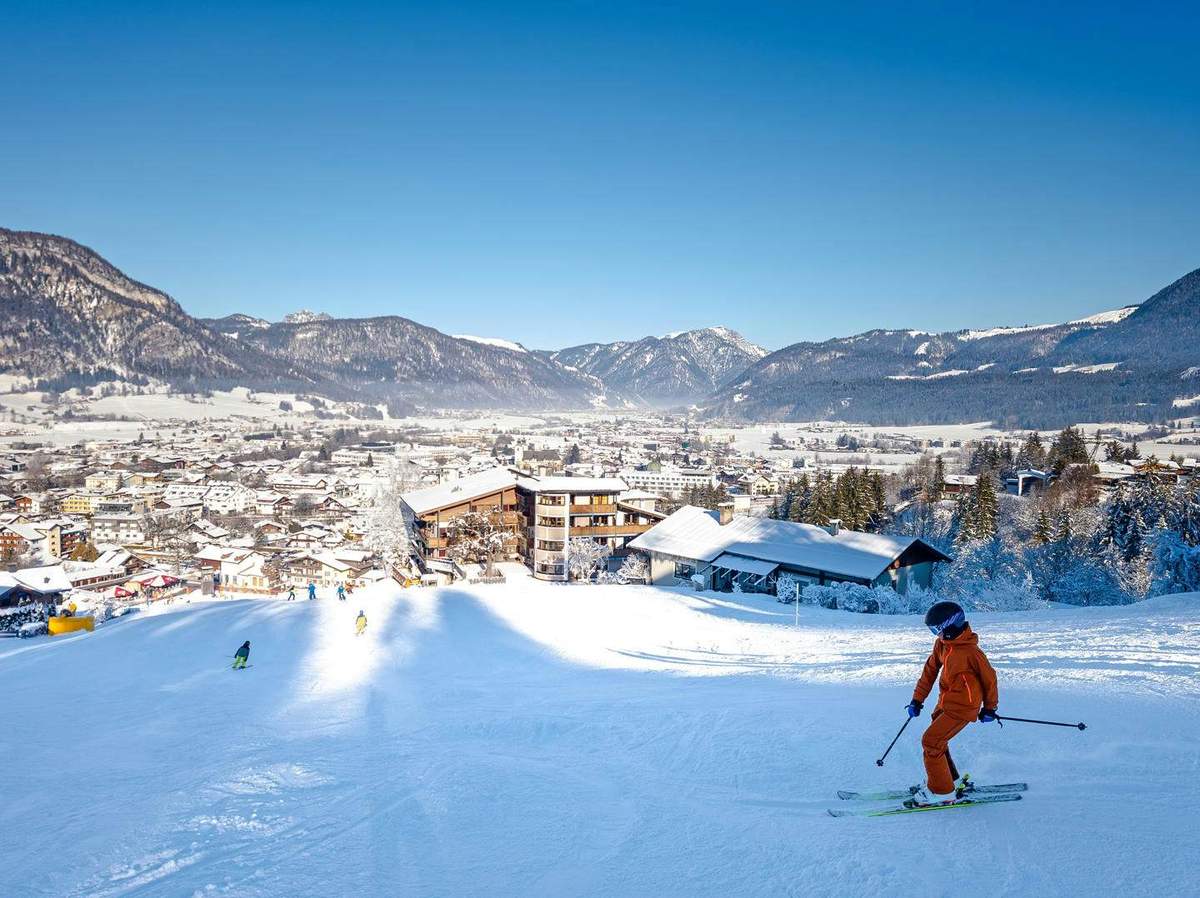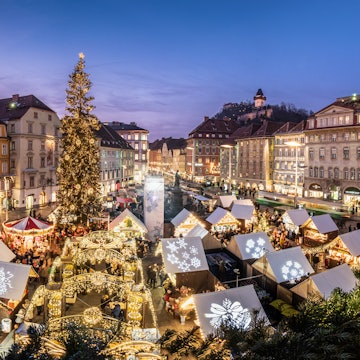
The 10 best museums in Salzburg: from historic palaces to music heritage

Jun 6, 2025 • 6 min read

The historic city of Salzburg with traditional horse-drawn carriage and Hohensalzburg Fortress. canadastock/Shutterstock
Whether you’re into contemporary art, royal bling, bewigged composers or Christmas sparkle, Salzburg's extraordinary range of museums can keep you gleefully absorbed on days when the rain sweeps over the Alps. For centuries, the ruling prince-archbishops frenziedly built castles, abbeys and palaces in this city to hide away treasures from prying eyes.
And when it comes to music, you know the score. This is where Mozart was born and Maria taught the world to sing. Read on for our pick of Salzburg’s best museums.
Festung Hohensalzburg
Best for riches, puppetry and torture
Salzburg’s cake-topper of a fortress lifts the gaze from the moment you arrive. This 900-year-old castle fits the knights-in-shining-armor fantasy bill looks-wise. But its history is even more compelling. It started life as a humble bailey, built in 1077 by Gebhard von Helffenstein at a time when the Holy Roman Empire was at loggerheads with the papacy, and owes its current grandeur to Leonhard von Keutschach, prince-archbishop of Salzburg from 1495 to 1519 and the city's last feudal ruler.
While it’s tempting to simply roam the ramparts and swoon over the views of the Salzach River and Alps, it's wise to factor in time to see the castle’s clutch of museums. These include the dazzling Golden Hall, where the prince-archbishops once threw lavish banquets; the Marionette Museum, with its operatic collection of puppets from the Salzburg Marionette Theatre; and the Fortress Museum, which showcases a 1612 model of Salzburg, as well as medieval instruments, armor and some pretty grizzly torture devices.

Mozart's Birthplace and Residence
Best for classical music fans
Mozart assumes many forms in Salzburg these days – chocolate balls, bath ducks, aftershave, you name it – but to really get a handle on Austria’s A-list baroque composer, you’ll want to visit two museums devoted to the man and his music.
Begin at Mozart’s Birthplace, the bright-yellow townhouse on Getreidegasse where Wolfgang Amadeus Mozart was born in 1756 and spent the first 17 years of his life. Among the portraits, letters, instruments and family heirlooms, highlights include the mini-violin Mozart wowed royalty with as a toddler, plus a lock of his hair and buttons from his jacket.
Craving more space to entertain as Mozart shot to fame, the family moved to a more spacious, eight-room abode on the other side of the river in 1773, now Mozart’s Residence. This is where the increasingly prolific and revered Wolfgang composed works like The Shepherd King (K208) and Idomeneo (K366). Emanuel Schikaneder, Mozart’s close friend and the librettist of The Magic Flute, was a regular guest. Mozart’s original fortepiano is the star exhibit. As you explore, an audio guide serenades you with opera excerpts.

Museum der Moderne
Best for contemporary art
Salzburg generally moves to a traditional beat, but the Museum der Moderne swerves away from the historic with its outstanding exhibitions of 20th- and 21st-century art. Perched high on Mönchsberg’s cliffs and reached by a lift, the glass-and-white-marble, oblong-shaped gallery is the architectural antithesis to the whopping Hohensalzburg fortress on the other side of the hill.
The rotating exhibitions are incredibly varied, swinging recently from a history of early photography in Salzburg to sprawling installations by British artist Nika Neelova. While you’re up here, pop into m32 for coffee with a far-reaching view over Salzburg.
Rupertinum
Best for cutting-edge photography
Gathered around a beautiful baroque arcade in the Altstadt, the Rupertinum is the Museum der Moderne’s sister gallery. Here, the focus is on rotating exhibitions of modern art, in particular graphic works and photography, which are at times quite edgy and boundary-pushing.
Sound of Music World
Best for behind-the-scenes insights into the von Trapps
Did you know that there were 10, not seven, von Trapp children? Or that instead of climbing every mountain to Switzerland to escape the Nazis, the von Trapps left for the US, where their concerts were a success well into the 1950s? On Getreidegasse, in the beating heart of the Altstadt, Sound of Music World shines a light on the truth behind the Hollywood legend.
The focus here is less on warbling nuns and problems like Maria than the lives of the real von Trapp Family Singers and how the movie differs from reality. That said, true fans might well want to burst into song exploring the memorabilia, photos, costumes and furnishings that bring the story vividly to life.
Haus der Natur
Best for the kids
This hands-on museum takes a deep dive into nature (and human nature) in all its weird and most wondrous forms. Kids can brush up on their knowledge of dinosaurs and alpine crystals in the natural history rooms, and gape at bearded dragons and green mambas in the reptile enclosure. Budding scientists have a blast with hands-on experiments in the science museum, launching rockets, damming water, taking a biological tour of the human body and – literally – feeling Mozart’s music by stepping into a giant violin case.
Catch 10:30am breakfast time at the aquarium. You can see sharks on Mondays, octopus and moray eels on Tuesdays, archerfish on Wednesdays and piranhas on Thursdays.

Freilichtmuseum
Best for traditional Austrian crafts and trades
Giving you a taste of rural Austrian life over the past six centuries, the open-air Freilichtmuseum sits in the foothills of the 1973m (6473ft) peak of Untersberg on the city’s fringes. Allow time as there is lots to see on the 7km (4 mile) trail that takes you on a fascinating spin of 100 traditional dwellings, showcasing the crafts and trades of yore in everything from timber-built farmhouses to watermills, stables, threshing barns, chapels, breweries, laundries and grocery stores.
There’s plenty to amuse the kids, with an old-fashioned train to ride, goats to feed, butterflies to observe and a huge adventure playground to let off steam in. Bus 180 runs hourly from Salzburg's Hauptbahnhof; the journey takes around half an hour.
Residenz
Best for opulence and works by Old Masters
The icing on Salzburg’s UNESCO World Heritage cake is the lavish Residenz, the baroque palace where the prince-archbishops held court until the Hapsburgs rocked up in the 19th century. It’s still a grand affair today, with horse-drawn carriages pulling up out front, and state rooms that are a swirl of lace-fine stucco, tapestries and frescoes by much-lauded Austrian painter Johann Michael Rottmayr.
Head up to the third floor Residenzgalerie for a feast of 16th- to 19th-century art. The gallery is particularly strong on Flemish and Dutch masters, with standouts like Rubens’ Allegory on Emperor Charles V and Rembrandt’s chiaroscuro Old Woman Praying.
Dommuseum
Best for sacred art
Sacred art lifts spirits to the heavens at the cathedral museum, where vaulted, stuccoed rooms hovering above the south side-aisle chapels display an astounding array of ecclesiastical treasures from the 8th to the 18th century.
Prepare to be dazzled by gem-encrusted monstrances, stained glass, altarpieces and one-off wonders like the Cross of St Rupert (750 CE), believed to be the largest surviving early medieval metal cross, which bears the hallmarks of both Anglo-Saxon and Mediterranean ornament.
One of the most exquisite rooms is given over to a cabinet of curiosities, showcasing marvels and oddities from globes to rare crystals and corals, armadillos to puffer fish, which would have baffled and beguiled baroque aristocrats with time and money to burn.
Christmas Museum
Best for year-round holiday spirit
If you are head-over-heels in love with Christmas, you won’t want to skip this museum above Café Glockenspiel on Mozartplatz. Here you can get a year-round flavor of the festive season, with a snoop through the private collection of yuletide treasures, from elaborately decorated advent calendars to hand-carved cribs, sparkly baubles, nutcrackers and incense smokers.















